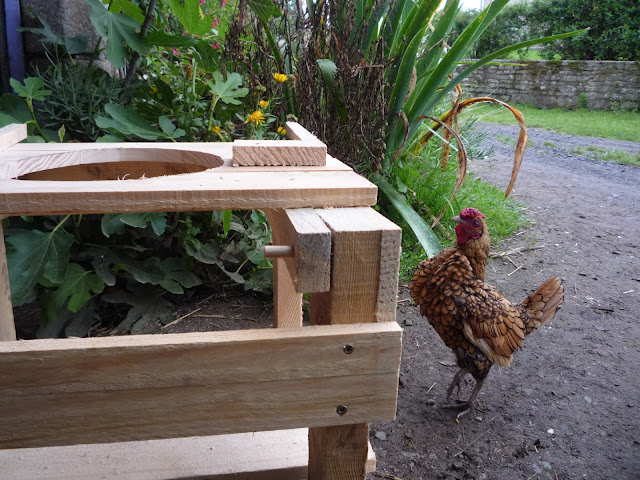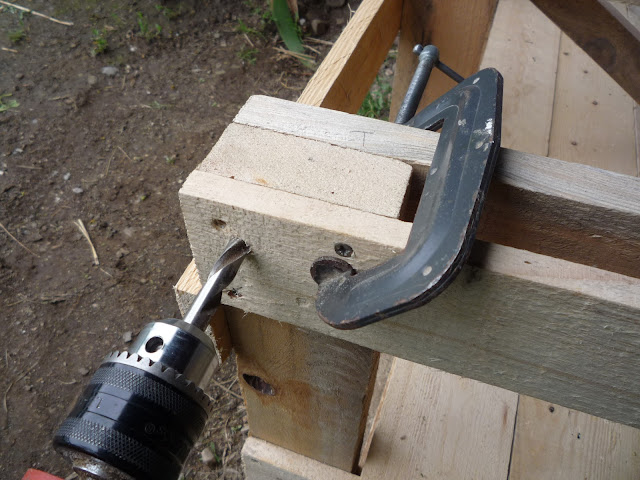There’s an old joke about thieves breaking into a local constabulary and stealing all their toilets. The next day it’s reported that:
“The police have nothing to go on.”
I realise how remiss I’ve been in not furnishing the details of the third, final and essential part of the dry toilet system and will correct this forthwith.
As this is quite a lengthy article, I have divided it into two. (If you are just coming to the dry toilet project for the first time, then part one of our whole set up, which includes details of the design and fabrication of the compost bin and cabin, can be found here.)
As this is quite a lengthy article, I have divided it into two. (If you are just coming to the dry toilet project for the first time, then part one of our whole set up, which includes details of the design and fabrication of the compost bin and cabin, can be found here.)
 |
Work in progress - Bob the Sebright aka the Guv'nor
Introduction
The toilet seat is for the ‘two bucket’ system. One side is for collecting liquid and the other is for solids. Needless to say one cannot avoid some liquid in the latter bucket but it is minimal and will be absorbed by the sawdust that is added after every visit. The idea is that the solids bucket is dry enough to permit the aerobic bacteria to get to work . The liquid waste can be disposed of separately either diluted with rainwater and used directly on the garden or put into the urine composter (see related post below). The other bonus for us is that when we’re working in the garden it’s really handy having a toilet where you don’t have to worry about taking off your wellies or muddy work boots to have a pee!
Design
The receptacles for the waste are two identical size buckets. It is the size of these buckets which determine the distance of their support shelf. from the underside of the seat. The hinged seats are made of wood and have a hinged cover over the top. It would be possible to purchase a couple of toilet seats and attach them to the base, but my intention was to make everything from re-purposed wood (except the buckets).
The important dimension was the seat height and this I measured from that of a conventional toilet.
Construction
The seat carcass was made of 3 rectangular frames oriented front to rear connected by top and bottom rails. The front elevation was clad in planking. The upper face of the frames was the face against which the seat rested. I first selected the wood I was to use for the seat.. The thickness of this wood had to be included in the dimension for the overall seat height.
There were six legs in all and they were cut from the stringers of a two-way entry pallet. They usually have a cross-section of around 29mm x 80mm (1¼” x 3¼”).
 Each pair of legs were joined with pallet planks (leg braces) 18mm x 80mm (¾” x 3¼”) at the top of the leg and at the bottom. The position of the lower leg brace had to be determined such that its upper edge would carry the horizontal planks upon which the buckets rested. So in my case, the distance from the top of the leg to the upper face of the lower leg brace was determined to be: the bucket height (260mm) plus the horizontal bucket support plank thickness (18mm) i.e. 278mm (11”).
Each pair of legs were joined with pallet planks (leg braces) 18mm x 80mm (¾” x 3¼”) at the top of the leg and at the bottom. The position of the lower leg brace had to be determined such that its upper edge would carry the horizontal planks upon which the buckets rested. So in my case, the distance from the top of the leg to the upper face of the lower leg brace was determined to be: the bucket height (260mm) plus the horizontal bucket support plank thickness (18mm) i.e. 278mm (11”).
The top edges of the upper leg braces of the frames were flush with the top of the leg. The centre leg frame had the leg braces on both faces of the legs so as to furnish support for each seat. Each frame was assembled with wood glue and screws, It was essential that the screws at the upper rear corners were not going to foul the location for the hole for the hinge dowel for the seat.
The hinges for the seat and lid were simply pivots made from wooden dowel passing through drilled holes in the upper leg braces into holes in the seat and lid supports. In the first incarnation of the seat, I made the base and then drilled the hinge holes in the frame using the fully assembled seat and hinge as the guide. I found it was very difficult to get the electric hand drill in position to drill the centre hinge hole due to the length restriction. So subsequent constructions had the hinge holes drilled in the seat and lid supports before they were assembled. This obviously meant that I had already selected the timber for the seat supports as it was in these that the other hinge holes were drilled.
The position for the dowel hole was marked on the side frame and the hole was drilled To lessen the chance of the drill wandering, I drilled a pilot hole and then ’opened up’ this hole with drill bits of increasing diameter.
To check the accuracy of the hole position, I stood the three side frames together on a flat surface with the legs aligned and pushed a piece of wooden dowel through the drilled holes.
To check the accuracy of the hole position, I stood the three side frames together on a flat surface with the legs aligned and pushed a piece of wooden dowel through the drilled holes.
The frame for the base was then assembled. Front and rear rails cut from pallet planks were screwed to the outward-facing elevation of the front legs of the side frames, at the top and the bottom and the inside edge of the rear legs of the side frames, checking that the frame remained square.
The seat supports were of the ‘stringer’ timber from a pallet cut to 28mm (11/8”) width and cut to length. For drilling the pivot hole in these, the supports were clamped against the side frame in the correct position and the hole in the side frame became the guide for the drill bit.
In the second and final part of this project I'll describe the making of the seat top and lid and fitting the finished project into the cabin. There will also be a film of the whole process.
All the best and thanks for dropping by. Please feel free to share this article, comment and/or ask for further information.
The continuation of this project can be found here
Until next time!
Cheers, Andy
© Andy Colley 2015
RETURN TO GREEN LEVER CONTENTS PAGE FOR MORE ARTICLES








No comments:
Post a Comment